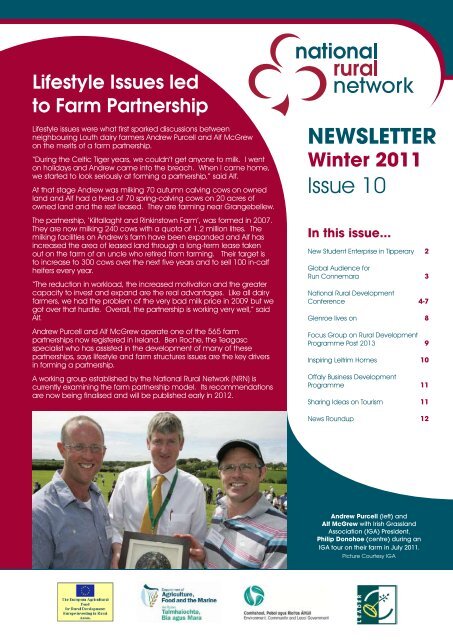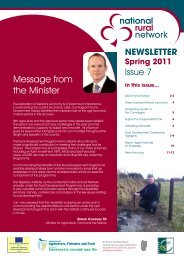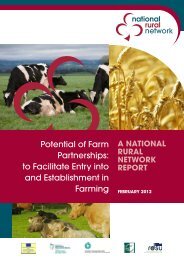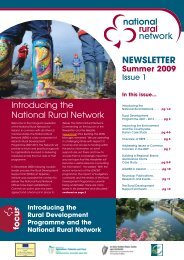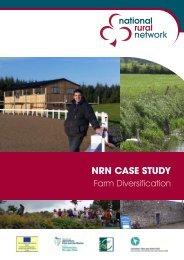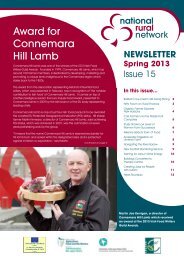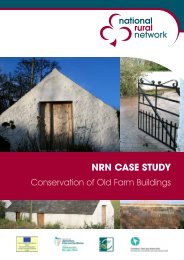NRN Newsletter â Issue 10 â Winter 2011 - National Rural Network
NRN Newsletter â Issue 10 â Winter 2011 - National Rural Network
NRN Newsletter â Issue 10 â Winter 2011 - National Rural Network
You also want an ePaper? Increase the reach of your titles
YUMPU automatically turns print PDFs into web optimized ePapers that Google loves.
R<br />
N N<br />
NATIONAL<br />
RURAL NETWORK<br />
R<br />
N N<br />
NATIONAL<br />
RURAL NETWORK<br />
Lifestyle <strong>Issue</strong>s led<br />
to Farm Partnership<br />
NATIONAL<br />
RURAL NETWORK<br />
Lifestyle issues were what first sparked discussions between<br />
neighbouring Louth dairy farmers Andrew Purcell and Alf McGrew<br />
on the merits of a farm partnership.<br />
“During the Celtic Tiger years, we couldn’t get anyone to milk. I went<br />
on holidays and Andrew came into the breach. When I came home,<br />
we started to look seriously at forming a partnership,” said Alf.<br />
At that stage Andrew was milking 70 autumn calving cows on owned<br />
land and Alf had a herd of 70 spring-calving cows on 20 acres of<br />
owned land and the rest leased. They are farming near Grangebellew.<br />
The partnership, ‘Kiltallaght and Rinkinstown Farm’, was formed in 2007.<br />
They are now milking 240 cows with a quota of 1.2 million litres. The<br />
milking facilities on Andrew’s farm have been expanded and Alf has<br />
increased the area of leased land through a long-term lease taken<br />
out on the farm of an uncle who retired from farming. Their target is<br />
to increase to 300 cows over the next five years and to sell <strong>10</strong>0 in-calf<br />
heifers every year.<br />
“The reduction in workload, the increased motivation and the greater<br />
capacity to invest and expand are the real advantages. Like all dairy<br />
farmers, we had the problem of the very bad milk price in 2009 but we<br />
got over that hurdle. Overall, the partnership is working very well,” said<br />
Alf.<br />
Andrew Purcell and Alf McGrew operate one of the 565 farm<br />
partnerships now registered in Ireland. Ben Roche, the Teagasc<br />
specialist who has assisted in the development of many of these<br />
partnerships, says lifestyle and farm structures issues are the key drivers<br />
in forming a partnership.<br />
A working group established by the <strong>National</strong> <strong>Rural</strong> <strong>Network</strong> (<strong>NRN</strong>) is<br />
currently examining the farm partnership model. Its recommendations<br />
are now being finalised and will be published early in 2012.<br />
<strong>Newsletter</strong><br />
<strong>Winter</strong> <strong>2011</strong><br />
<strong>Issue</strong> <strong>10</strong><br />
In this issue...<br />
New Student Enterprise in Tipperary 2<br />
Global Audience for<br />
Run Connemara 3<br />
<strong>National</strong> <strong>Rural</strong> Development<br />
Conference 4-7<br />
Glenroe lives on 8<br />
Focus Group on <strong>Rural</strong> Development<br />
Programme Post 2013 9<br />
Inspiring Leitrim Homes <strong>10</strong><br />
Offaly Business Development<br />
Programme 11<br />
Sharing Ideas on Tourism 11<br />
News Roundup 12<br />
Andrew Purcell (left) and<br />
Alf McGrew with Irish Grassland<br />
Association (IGA) President,<br />
Philip Donohoe (centre) during an<br />
IGA tour on their farm in July <strong>2011</strong>.<br />
Picture Courtesy IGA
New Student Enterprise in Tipperary<br />
Schools from as far away as Drogheda and Dublin are<br />
sending their agricultural science students to Coorevin<br />
Farm at Borrisokane, Co Tipperary to get a practical feel for<br />
farming. The innovative project, called ‘Moran’s Agricultural<br />
Experience for Students’ was developed by Padraig and<br />
Nuala Moran, owners of Coorevin Farm.<br />
“Our two sons, Ronan and Eoin, did agricultural science<br />
for the Leaving and I got roped into doing projects. I also<br />
found myself helping local students from non-farming<br />
backgrounds with their projects. So I decided why not try<br />
this on a wider scale,” said Padraig.<br />
He converted a building into a class room and started to<br />
make contact with schools. The first students arrived at the<br />
farm last March. He has now hosted <strong>10</strong> schools on the farm<br />
and the number of queries is growing. The typical size of<br />
group is around 40 students.<br />
The Morans run an intensive beef and sheep enterprise on<br />
50 ha. The progeny from the 40 suckler cows are sold at 12<br />
months. Half the lambs from the 150 January-lambing ewe<br />
flock are sent to the factory and the remainder are sold<br />
directly to local consumers for home freezers.<br />
Passion<br />
Through Padraig’s communications skills and his passion for<br />
his chosen career, students get a real practical experience<br />
of the scientific and management aspects of a modern<br />
farm. He feels that, ideally, students should come twice to<br />
the farm to see the different stages of animal development<br />
and different management practices. One Dublin school<br />
has done that already this year.<br />
While some schools take their agricultural science students<br />
to agricultural colleges, Padraig feels there is too much for<br />
the student to take during a one-day visit. “In our case,<br />
students can concentrate on just two enterprises and<br />
therefore come away with real knowledge,” he said.<br />
He had to fully familiarise himself with the agricultural<br />
science syllabus and is very critical that students are<br />
following a syllabus that has not been updated in 40 years.<br />
He said much of the material in the syllabus is completely<br />
outdated although the new textbook on ‘Pastures New’<br />
is quite good. The new text book was produced by Agri<br />
Aware, the Agricultural Science Teachers Association and<br />
the Farmers Journal.<br />
Synergy<br />
Padraig is very complimentary of Agri Aware which has<br />
given him a lot of help in marketing his new enterprise. He<br />
has recently become a patron of Agri Aware and believes<br />
there is a strong synergy between the aims of his business<br />
and those of Agri Aware.<br />
Coorevin Farm has become a patron of Agri Aware.<br />
Pictured at the announcement are, from left:<br />
Bernard Donohue, Chairman Agri Aware, Padraig Moran,<br />
Coorevin Farm, Dr Vanessa Woods, Executive Director<br />
Agri Aware and Nuala Moran, Coorevin Farm.<br />
Padraig Moran addressing students from<br />
Presentation Secondary School Thurles<br />
during a visit to Coorevin Farm in November.<br />
Coorevin Farm is in REPS 4 and Padraig is a REPS<br />
demonstration farmer. The farm and classroom are used for<br />
training courses for REPS participants in north Tipperary. He<br />
is also a benchmark farm for Gurteen agricultural college<br />
and his facilities are used to host discussion groups involving<br />
mature students participating in training courses at Gurteen<br />
in order to meet requirements for various schemes in<br />
farming.<br />
The facilities have also been used for meetings and<br />
‘think-ins’ by agencies such as Offaly Local Development<br />
Company. The Morans are currently constructing a wetroom<br />
for students. The development is being supported by<br />
North Tipperary LEADER Partnership.<br />
Footsteps<br />
The two Moran sons are following in their father’s footsteps.<br />
Both did agricultural science to Leaving Cert level.<br />
Ronan then studied agricultural science/environmental<br />
management at GMIT and is now working with Arrabawn<br />
Co-op. Eoin has just completed a two year drystock<br />
management course at Gurteen.<br />
An Ideal Location<br />
An ideal location for students to get practical experience of modern farming is how agricultural science<br />
teacher, Patricia Stapleton, describes Coorevin Farm. Patricia who teaches at Presentation Secondary School,<br />
Thurles, brought her fifth year agricultural science class to Coorevin Farm in October. She heard about the new<br />
facility through a leaflet dropped to the school.<br />
“Padraig Moran is very knowledgeable on animal breeding, housing, grassland management and systems<br />
and types of feeding. The feedback from the students was very positive. A number of the students have no<br />
background in farming and the experience was really beneficial for them,” she said.<br />
p
N N<br />
NATIONAL<br />
RURAL NETWORK<br />
Global Audience for<br />
Run Connemara<br />
Run Connemara, the spectacular<br />
70 km UltraRunning World Trail<br />
Championships that took place<br />
last July, has reached a global<br />
television audience in excess of 150<br />
million households – an exposure<br />
worth many millions of euro. The<br />
event resulted from an innovative<br />
partnership between the Renvylebased<br />
voluntary community group,<br />
Run Connemara and Ultra Running,<br />
the official Irish representatives for<br />
ultra distance running.<br />
Last January, Richard Donovan,<br />
chairman of Ultra Running Ireland<br />
(URI) asked Kevin Heanue, chairman<br />
of Connemara West – they are<br />
friends from their student days<br />
in NUIG – about the possibility of<br />
Connemara hosting the Trail World<br />
Championships. Kevin, a Renvyle<br />
native and a Teagasc economist,<br />
specialising in innovation, put<br />
the proposition to his committee<br />
in Connemara West and got an<br />
immediate positive response.<br />
“We saw it as an opportunity to<br />
showcase the area to a global<br />
audience and brand it as a place<br />
to visit for outdoor activities and also<br />
to enjoy the landscape, culture and<br />
hospitality,” said Kevin.<br />
R<br />
N N<br />
R<br />
N N<br />
Kevin Heanue<br />
Chairman Run Connemara.<br />
an event worker who was taken on to<br />
deliver the project.<br />
Twenty national teams participated<br />
in the gruelling 70km race on Sunday<br />
9 July. Athletes from as far away<br />
as Australia, Nepal, Argentina, USA<br />
and Canada were among the<br />
130 who competed in the off-road<br />
course encompassing mountains,<br />
gravel, loose rock, bog and open<br />
countryside.<br />
“One of the remarkable successes<br />
of this event is that a new brand, Run<br />
Connemara, was developed and<br />
trademarked and has got global<br />
coverage within the space of six<br />
months,” said Kevin Heanue.<br />
Ambassadors<br />
The television coverage of the event<br />
has been remarkable. As well as<br />
NATIONAL<br />
RURAL NETWORK<br />
NATIONAL<br />
RURAL NETWORK<br />
NATIONAL<br />
RURAL NETWORK<br />
Channel 4, Setanta and TG4, where<br />
it has had a number of showings, it<br />
has also been shown on at least 15<br />
channels internationally including in<br />
Asia, Canada, Africa, Australia and<br />
the USA. As a result of the coverage,<br />
runners are coming to Connemara to<br />
run part, or all, of the route.<br />
“The overwhelming response from<br />
participants, officials and families<br />
was that the event was an incredible<br />
success. These people will be great<br />
ambassadors for Connemara,” said<br />
Kevin Heanue.<br />
For the record, France swept the<br />
boards on the day, winning both<br />
the individual and team events for<br />
men and women. The Irish team<br />
was seventh overall and Irish runner<br />
Daniel Doherty finished in a very<br />
creditable 17th place.<br />
Trademark<br />
Run Connemara was established<br />
with Kevin Heanue as chairman.<br />
A logo was developed and<br />
trademarked, a website was<br />
established and negotiations were<br />
completed with DreamTeam TV to<br />
produce a film on the event. Kevin<br />
and Richard got financial support<br />
for the event from Galway County<br />
Council, Fáilte Ireland, the Irish Sports<br />
Council, the Irish Athletics Association<br />
and Connemara West plc. FORUM<br />
Connemara supported the cost of<br />
The start of the 70km UltraRunning World Trail Championships<br />
at the picturesque Kylemore Abbey in Connemara.<br />
“An Amazing Experience”<br />
“It was an amazing experience for me as an athlete competing in my first world championships. Everyone<br />
agreed it was one of the most challenging races they had ever run.” This is how Keith Whyte from Ennis, a<br />
member of the Irish team, described his experience.<br />
“The organising was top drawer. We had the official Olympics photographer there and television crews<br />
broadcasting to millions of viewers. The awarding of an international athletics Order of Merit to the organisers<br />
was fully deserved. This was the first time such an award was made,” said Keith.<br />
p
<strong>National</strong> <strong>Rural</strong> Development Conference<br />
Will the New CAP Fit<br />
The <strong>National</strong> <strong>Rural</strong> Development<br />
Conference, run by the <strong>National</strong><br />
<strong>Rural</strong> <strong>Network</strong> and Teagasc and<br />
held in Athlone on 19 October,<br />
was attended by over 250<br />
rural development activists,<br />
entrepreneurs and representatives<br />
of rural organisations. The theme of<br />
the conference was ‘Towards 2020<br />
– Building a Vibrant <strong>Rural</strong> Economy.’<br />
A total of 25 speakers and panellists<br />
addressed the morning plenary<br />
session and afternoon workshops<br />
and ensured an event of solid<br />
information and lively debate<br />
on critical aspects of the rural<br />
economy. As the conference took<br />
place just seven days after the<br />
publication of the EU Commission<br />
proposals on the CAP post 2013, the<br />
potential impact on the agri-food<br />
industry and rural areas was the<br />
subject of intense debate.<br />
period 2014-2020 is very satisfactory<br />
given the political imperative<br />
to redistribute funds to the new<br />
Member States.<br />
However, he felt it would be more<br />
difficult for Ireland to maintain its<br />
existing share of funding on rural<br />
development measures, particularly<br />
where greater emphasis is given<br />
to the use of objective criteria in<br />
allocating funds across Member<br />
States.<br />
Prof Matthews said the greening<br />
measures proposed as part of<br />
the Single Farm Payment will have<br />
implications for agri-environment<br />
schemes because they will raise<br />
the baseline level of compliance.<br />
He welcomed the Commission’s<br />
acknowledgement that declining<br />
growth rates for agricultural<br />
productivity pose a huge challenge<br />
for the global competitiveness of<br />
European agriculture.<br />
“A good outcome for the agriculture<br />
and rural sectors” was how Professor<br />
Alan Matthews of Trinity College<br />
described the proposals in his<br />
conference keynote address. He<br />
said the proposal to reduce the<br />
level of Single Farm Payment to<br />
Irish farmers by less than 2% in the<br />
Speakers at the <strong>National</strong> <strong>Rural</strong> Development Conference, from left:<br />
Prof. Gerry Boyle, Teagasc, Dr Edgar Morgenroth, ESRI, Prof Alan Matthews,<br />
TCD and Dr Maria Hinfelaar, President Limerick Institute of Technology.<br />
A section of the attendance at the conference.<br />
p
N N<br />
NATIONAL<br />
RURAL NETWORK<br />
Conference Highlights<br />
Two-Speed <strong>Rural</strong> Economy<br />
Dr Edgar Morgenroth of the Economic and Social<br />
Research Institute (ESRI) highlighted the emergence of a<br />
two-speed rural economy. He said that while agriculture<br />
in Ireland has a strong future, the trend of reducing<br />
employment in farming is unlikely to be reversed.<br />
“Regions with strong commercial farming will continue to<br />
hold their own or even increase in vibrancy while areas<br />
that are not suited to intensive, commercial farming will<br />
continue to decline. In these areas, other employment<br />
will be important.”<br />
“However, the scope for generating employment is<br />
limited due to structural deficits such as high average<br />
age, low population, relative remoteness and poor<br />
urban structure,” he said.<br />
Dr Morgenroth said the highest value, highest wage jobs<br />
tend to be in urban centres. “There is extensive research<br />
that suggests that growth in Ireland will be predominantly<br />
urban. Even the food industry is predominantly urban,<br />
with 53% of jobs located in urban areas.”<br />
Green Heroes Programme<br />
“A lot of countries claim to be green<br />
– so Ireland needs to generate a unique<br />
meaning that is credible,” Padraig<br />
Brennan of Bord Bia told the conference.<br />
“We need to extend beyond carbon<br />
proofing to a focus on water and<br />
biodiversity. In developing our green<br />
credentials, we need to establish a<br />
‘Green Heroes Programme’ which<br />
will act as a platform from which to<br />
effectively communicate and prove the<br />
R<br />
N N<br />
R<br />
N N<br />
NATIONAL<br />
RURAL NETWORK<br />
NATIONAL<br />
RURAL NETWORK<br />
NATIONAL<br />
RURAL NETWORK<br />
Ger Bergin (left), IFA Vice-President with<br />
Norina Coppinger, Teagasc and Gerry Gunning,<br />
Executive Secretary IFA <strong>Rural</strong> Development Committee<br />
at the conference.<br />
sustainability credentials of Ireland’s food<br />
producers.”<br />
“Sustainability can deliver improved<br />
efficiencies and reduced costs. In beef<br />
production, every five kg of CO 2 equivalent<br />
reduction in emissions per kg live weight is<br />
associated with a 50c/kg improvement in<br />
financial margin. In sheep, every 1kg of<br />
CO 2 equivalent reduction in emissions per<br />
kg live weight is associated with a 28c/kg<br />
improvement in financial margin,” he said.<br />
Padraig Brennan<br />
Bord Bia.<br />
Roscommon delegates at the conference, from left: Oliver Burke, Teagasc Area Manager, Patsy Daly<br />
and Kevin McBrien, Roscommon LEADER Partnership, and Joe Curtin, Teagasc Adviser.<br />
p
Conference Highlights<br />
Walking Trails Explosion<br />
The number of recognised wayward walking trails in<br />
Ireland has increased dramatically in recent years, from<br />
72 in 2005 to 549 today, said Cormac MacDonnell from<br />
the <strong>National</strong> Trails Office.<br />
The number of overseas visitors engaged in walking and<br />
hiking grew by 34% between 2008 and 20<strong>10</strong> and now<br />
totals around 350,000 per year. He said a study has<br />
shown that overseas visitors engaged in hiking and hill<br />
walking generated €500m in 20<strong>10</strong>, of which €150m was<br />
spent on visits to recognised walking trails.<br />
Cormac MacDonnell highlighted the need for stronger<br />
emphasis on trail branding and promotion and for<br />
improved information to trail users about local services.<br />
The linkages between local development agencies,<br />
land owners, local enterprise and promotion bodies also<br />
need to be improved.<br />
Karl Boyle of Mountaineering Ireland talked about the<br />
need to develop an umbrella ‘Brand Ireland’ and for<br />
training in trail building.<br />
Other Conference<br />
Quotes...<br />
“There are currently 400 speciality food companies<br />
employing over 3,000 people with an estimated<br />
value of €475 million. The sector is growing by <strong>10</strong>%<br />
annually.” - Dr Cathal O’Donoghue, Head of Teagasc<br />
<strong>Rural</strong> Economy Development Programme.<br />
“There were 250 community-owned shops in England<br />
and Wales in 20<strong>10</strong>, an increase of almost five-fold on<br />
the 2000 figure. Around 1.2m hours of voluntary time<br />
is devoted every year to these shops.”<br />
<br />
– Peter Couchman, the Plunkett Foundation.<br />
“Achieving the 2020 bio-energy targets will create<br />
8,000 net new jobs.”<br />
– Tom Bruton, President Irish Bio-Energy Association.<br />
“Achieving the growth targets in the Food Harvest<br />
2020 report has the potential to make a major<br />
contribution to rural development in Ireland, through<br />
improved farm viability and additional jobs in<br />
existing and new food businesses.”<br />
<br />
– Prof Gerry Boyle, Director Teagasc.<br />
“Developing farming in an environmentally<br />
conscious manner should not be seen as entirely<br />
negative as it will allow other opportunities to arise.”<br />
– Tommy Cooke, Chairman Irish Wind Farmers Co-op.<br />
“In Irish poultry production, the total energy<br />
consumed per bird is almost twice that of the UK,”<br />
– Tom Bruton, President Irish Bio-Energy Association<br />
Michael Ludlow, Meath Partnership,<br />
Tom Bruton, Irish Bio-Energy Association and<br />
Dr Pat Bogue, <strong>National</strong> <strong>Rural</strong> <strong>Network</strong> at the conference.<br />
Mid-East the Biggest<br />
Employer<br />
The Mid-East region has the highest levels of employment<br />
and the Border and South-East regions have the lowest levels,<br />
figures presented by Jason Loughrey, post-graduate research<br />
student with Teagasc, showed.<br />
<strong>National</strong>ly, the proportion of the population in employment<br />
dropped from 60.3% in 2006 to 52% in <strong>2011</strong>. In the Mid-East,<br />
the employment rate has dropped from 63.5% in 2006 to<br />
56.4% in <strong>2011</strong>. Employment in the Border region has dropped<br />
from 57.1% to 47.1% while in the South-East employment<br />
has dropped from 58.8% to 47.5% between 2006 and <strong>2011</strong>.<br />
Current employment rates in the other regions are: Midland<br />
– 49.6%; West – 52.2%; Mid-West – 53%; South-West – 50.9%;<br />
Dublin – 54.6%.<br />
Jason presented figures on employment and income trends<br />
in Meath. They show that average disposable household<br />
income in the county, at just over €44,000 in <strong>2011</strong>, dropped<br />
by 4.6% since 2006. The south west of the county is worst<br />
affected in both income and employment while the south east<br />
– part of the Dublin labour market – has maintained relatively<br />
high employment rates and has experienced little or no<br />
change in disposable household income.<br />
Male employment rate in Meath has dropped by 17% since<br />
2006. The decline in construction is a key contributor as, at the<br />
height of the boom, 14% of the Meath workforce was involved<br />
in construction compared to 11.1% nationally.<br />
Another statistic presented by Jason showed that between April<br />
20<strong>10</strong> and April <strong>2011</strong>, annual emigration among Irish nationals<br />
rose by 52%, from 27,700 to 40,200.<br />
p
N N<br />
NATIONAL<br />
RURAL NETWORK<br />
Conference Highlights<br />
Changing Farm Structures<br />
The changing structure of farming in Ireland was<br />
outlined by Teagasc research scientist, David Meredith.<br />
The number of farms between <strong>10</strong> and 20 ha dropped<br />
by over 35% between 1990 and 2007 while the<br />
number in the 50-<strong>10</strong>0 ha size bracket increased by<br />
15%.<br />
Average farm size in 2007 was 32.2 ha, an increase<br />
of 24% on the figure in the early 1990s. The number<br />
employed in farming now stands at 80,000, a drop of<br />
60% on the figure in 1981.<br />
He used the Mitchelstown local labour market area as<br />
an example of the contribution of the agri-food sector<br />
to employment and economic vibrancy, particularly in<br />
R<br />
N N<br />
R<br />
N N<br />
NATIONAL<br />
RURAL NETWORK<br />
NATIONAL<br />
RURAL NETWORK<br />
NATIONAL<br />
RURAL NETWORK<br />
the intensive farming areas.<br />
“The 2006 Census showed there were 671 farmers in<br />
the Mitchelstown area. The area had 116 enterprises<br />
processing farm products, selling inputs and providing<br />
a wide range of services to farmers.”<br />
“When the total number of jobs associated with the<br />
agri-food industry in the Mitchelstown labour market<br />
area is added up, they account for an estimated 25%<br />
of employment in the area. While Mitchelstown is<br />
probably as good as it gets, there are other intensive<br />
farming areas where the agri-food sector is of similar<br />
central importance to the local economy,” said David<br />
Meredith.<br />
Wind Update<br />
Tommy Cooke, chairman of the<br />
Irish Wind Farmers Co-operative,<br />
told the conference that almost<br />
1800 MW of wind energy is now<br />
installed in Ireland. A further 3900<br />
MW Gate 3 connection offers are<br />
currently being issued and there is<br />
over 6000 MW in the queue.<br />
“But there are problems – in cost<br />
and delays in grid connection and<br />
in regulatory and REFIT uncertainty.<br />
There is a woefully inadequate<br />
REFIT for small and micro scale<br />
wind and there are financing<br />
problems,” he said.<br />
Ciaran Lynch (left), <strong>National</strong> <strong>Rural</strong> <strong>Network</strong> with conference speakers<br />
David Meredith, Teagasc and Tommy Cooke, Irish Wind Farmers Co-op.<br />
Bernie Leavy and Joe Potter,<br />
Westmeath Community<br />
Development pictured at the<br />
conference.<br />
Mary Mullen and Elaine Halpin, Cavan-Monaghan LEADER with<br />
Gabriel O’Connell, Monaghan Integrated Development and Jim Maguire,<br />
Breffni Integrated Development at the <strong>Rural</strong> Development Conference.<br />
p
Glenroe Lives On<br />
The famous farming soap, Glenroe,<br />
may have disappeared from our<br />
screens <strong>10</strong> years ago but Glenroe Farm<br />
is still enjoyed by thousands every year.<br />
The 28 ha farm at Kilcoole, Co Wicklow<br />
is run by John and Teresa Toner and is<br />
one of the longest running open farms<br />
in the country.<br />
John took over the farm from his<br />
father in 1984, a year after RTE started<br />
filming Glenroe on the farm. As well<br />
as servicing the farming requirements<br />
of Dinny and Miley, the farm was run<br />
commercially and John also rented 60<br />
ha for potatoes and cattle.<br />
In 1994, he gave up renting land and<br />
decided to develop an open farm at<br />
Kilcoole. Wesley Burrowes, the Glenroe<br />
script writer, adapted the story line<br />
to the needs of the new enterprise<br />
and the open farm and the television<br />
programme operated in tandem until<br />
2001 when Glenroe was taken off the<br />
air.<br />
Vulnerable<br />
Glenroe Open Farm now employs one<br />
person full-time and has a further 18<br />
part-time staff. Around 25,000 visitors<br />
come to the farm every year, many<br />
of them from south Dublin, Bray and<br />
Greystones. But it is vulnerable to the<br />
vagaries of the weather.<br />
Santa arrived at the farm on the last<br />
A Fallow deer and her fawn,<br />
one of the many attractions at Glenroe Open Farm.<br />
weekend of November 20<strong>10</strong>. “Then<br />
the snow came and the entire month<br />
of December was a washout. We had<br />
a great March and April this year but<br />
the summer was very cold and that<br />
affected numbers. The economic<br />
downturn has also impacted,<br />
particularly on tours for school children,”<br />
said John.<br />
While there is a nature trail running<br />
through the farm as part of the visitor<br />
attraction, much of the 28 ha is still<br />
farmed commercially with cattle, sheep<br />
and tillage. The open farm is open<br />
to groups during the week and to the<br />
public at weekends. When we called<br />
on the third weekend of December,<br />
Santa was snug in Dinny’s house, the<br />
350 year old cottage that was used as<br />
the home for Dinny Byrne during the<br />
18 years of the Glenroe series. He was<br />
a big attraction for the four weekends<br />
leading up to Christmas.<br />
Santa arriving at Glenroe Open Farm for Christmas <strong>2011</strong>.<br />
p
N N<br />
NATIONAL<br />
RURAL NETWORK<br />
NATIONAL<br />
RURAL NETWORK<br />
Focus Group on <strong>Rural</strong><br />
Development Programme<br />
Post 2013<br />
R<br />
N N<br />
R<br />
N N<br />
NATIONAL<br />
RURAL NETWORK<br />
NATIONAL<br />
RURAL NETWORK<br />
For the past 12 months, Ryan Howard, Chief Executive<br />
of South & East Cork Area Development (SECAD), is a<br />
member of an EU Commission LEADER Focus Group on<br />
post-2013 funding of the rural development programme<br />
and on developing better local development strategies.<br />
The group has members from all 27 member states,<br />
including representatives from Local Action Groups<br />
(LAGS). The other Irish representative on the group is<br />
Deirdre Kelly from the Department of Environment,<br />
Community and Local Government.<br />
Ryan describes the work of the focus group as a “very<br />
worthwhile exercise”. Many of the recommendations<br />
made by the group have found their way into the<br />
Commission’s legal proposals on the reform of the<br />
Common Agricultural Policy which were published on 12<br />
October.<br />
“The overall feeling of representatives of LAGS across<br />
member states is one of frustration with the operation<br />
of the current programme. The integrity of local<br />
interpretation and honouring the local decision are big<br />
issues across the EU and are essential in the successful<br />
delivery of a LEADER approach.”<br />
“However, the group is pleased that many of its<br />
recommendations have found their way into the new<br />
framework proposals. Furthermore, under the draft<br />
‘Common Strategic Framework’ the Commission<br />
is suggesting that the LEADER approach should be<br />
considered as an option in the delivery of other funds<br />
such as the ESF, ERDF and European Fisheries Programme<br />
from 2014 onwards,” he said.<br />
The group had access to many of the most senior officials<br />
in the Commission, not just in DG AGRI but also in the<br />
Ryan Howard,<br />
on EU LEADER Focus Group.<br />
Social Fund, the Regional Fund and the Marine Fund.<br />
Ryan Howard is struck with how impressed these senior<br />
officials are with the LEADER approach, notwithstanding<br />
the many inadequacies in its delivery on the ground.<br />
“The top officials in charge of the European Social Fund,<br />
which has a fund of €90 bn, would love to see groups<br />
like us involved in operating the fund at local level. We<br />
found a similar enthusiasm from the people we met in the<br />
regional and marine funds,” said Ryan.<br />
The group is now working on developing proposals<br />
that will lead to better local structures and local<br />
decision-making processes in the operation of the rural<br />
development programme post 2013. Based on its<br />
experience to date, Ryan Howard is confident that it can<br />
make a difference and ensure that a programme with a<br />
real ‘bottom-up’ approach can be put in place.<br />
<strong>NRN</strong> Study on Community Development<br />
Securing the support of local<br />
leaders and engaging and nurturing<br />
relationships with local development<br />
and statutory agencies are key<br />
ingredients in the development of selfreliant<br />
rural communities, a study carried<br />
out on behalf of the <strong>National</strong> <strong>Rural</strong><br />
<strong>Network</strong> (<strong>NRN</strong>) concludes.<br />
The study on the rural community<br />
of Upperchurch-Drombane, Co<br />
Tipperary was carried out by Catherine<br />
Corcoran of LIT-Tipperary. It examines<br />
how this community became selfreliant<br />
and charts achievements and<br />
challenges. Among its conclusions and<br />
recommendations are:<br />
• Community groups need to secure<br />
the involvement of enthusiastic<br />
individuals to drive specific projects<br />
of particular interest to them. In<br />
Upperchurch-Drombane, the<br />
pioneers of some community<br />
projects were not core members of<br />
the Development Association but<br />
had the motivation and energy to<br />
ensure that the project succeeded.<br />
• Communities that have little<br />
contact with agencies or awareness<br />
of available initiatives should<br />
be indentified and proactively<br />
engaged with. The restrictions on<br />
the ways in which publicly-funded<br />
bodies engage with communities<br />
should be minimised.<br />
• In rural areas such as Upperchurch-<br />
Drombane, agriculture, rural and<br />
community development are<br />
synonymous and consideration<br />
should be given in future<br />
programmes for identifying ways in<br />
which support for agriculture can<br />
include community development<br />
outcomes.<br />
• Future rural development policy<br />
needs to include a focus on<br />
developing the capacity of<br />
communities to exploit assets such<br />
as tourism, food, water, air and<br />
energy in a sustainable way.<br />
The study on ‘Upperchurch-Drombane<br />
- <strong>Rural</strong> Community Development in<br />
Action’ will be available in January on<br />
the <strong>NRN</strong> website at www.nrn.ie.<br />
p
Inspiring Leitrim Homes<br />
A project funded by Leitrim<br />
Development Company has<br />
resulted in a catalogue of<br />
distinctive homes in the county<br />
and the development of a bank<br />
of information on a wide range<br />
of designs and expertise on<br />
cost-efficient home design and<br />
reconstruction.<br />
The Inspirational Homes project<br />
was undertaken by Jo Lewis<br />
who was contracted by Leitrim<br />
Development Company to<br />
collect information on homes<br />
with interesting and unique<br />
characteristics.<br />
Jo came to Leitrim about <strong>10</strong><br />
years ago from London where<br />
she and her husband had<br />
been running a vegetarian<br />
restaurant. The family spent<br />
seven years living in a mobile<br />
home while they renovated an<br />
old cottage in Dromahair. “If I<br />
had the information then that I<br />
have now, we would have done<br />
the renovation much faster and<br />
would have avoided many of the<br />
mistakes,” she said.<br />
Visitors discussing aspects of design in one of Leitrim’s<br />
Inspirational Homes during the ‘Green Door’ weekend.<br />
Over three-quarters of the home<br />
owners agreed to open their<br />
homes. The event attracted over<br />
600 visitors, including architects<br />
– some who travelled from<br />
London – builders and interested<br />
home owners from across the<br />
north west. A website www.<br />
inspirationalhomes.ie has been<br />
developed with information on<br />
the project and on the range of<br />
unique houses.<br />
Brian Smyth, who coordinated the<br />
project for Leitrim Development<br />
Company, said they are now<br />
looking at how to use the<br />
information in ways that will<br />
benefit the building sector and<br />
home owners in the county. Jo<br />
Lewis is hopeful that the project<br />
can be extended to other<br />
counties in the north west.<br />
She found around 40 houses with<br />
distinct characteristics. Many<br />
were self built, were low cost<br />
and had some form of ecotechnology<br />
such as geo-thermal,<br />
straw bale, timber-framed, selfheating<br />
or different wood-burning<br />
heating systems.<br />
“Many of these houses are tucked<br />
away in the deep countryside<br />
and it took quite a time to find<br />
them. Others are more public like<br />
the Dock arts centre in Carrickon-Shannon<br />
which has been<br />
beautifully restored from the old<br />
courthouse,” said Jo.<br />
A ‘Green Door’ event was<br />
organised over a weekend last<br />
September. Supported by Leitrim<br />
Development Company and<br />
Leitrim County Council, it involved<br />
home owners opening their doors<br />
and sharing their ideas with the<br />
public.<br />
One of the distinctive Leitrim homes found by Jo Lewis.<br />
p<strong>10</strong>
N N<br />
NATIONAL<br />
RURAL NETWORK<br />
N N<br />
NATIONAL<br />
RURAL NETWORK<br />
Offaly Business Development<br />
Programme<br />
Around 70% of participants in recent years in the<br />
Business Development Programme run by Offaly Local<br />
Development Company (OLDC) have succeeded in<br />
establishing their own businesses. The programme,<br />
which is funded by FÁS, is targeted at people who are in<br />
receipt of social assistance and have a business idea.<br />
Recruitment is through the FÁS Gateway system.<br />
There are 15 places on each 26-week programme which<br />
consists of classroom training and one-to-one tuition. The<br />
programme helps participants to investigate the viability of<br />
their business idea, develop effective business plans and<br />
get expert guidance in all areas of business development.<br />
R<br />
R<br />
N N<br />
NATIONAL<br />
RURAL NETWORK<br />
NATIONAL<br />
RURAL NETWORK<br />
Programme co-ordinator, Carmel Ormond of OLDC,<br />
said many of the participants in recent programmes are<br />
engineers, architects and skilled crafts people who had<br />
worked in the building sector. Some had never thought of<br />
self-employment before.<br />
The participants who graduated from one of the<br />
programmes conducted in <strong>2011</strong> have established a<br />
wide variety of businesses including tyre recycling, wood<br />
finishing and re-surfacing, a frock exchange service,<br />
graphic design, stairs and curved handrail manufacturing<br />
and fresh fish retailing.<br />
The 15 participants in the recent Business Development Programme run by Offaly Local Development Company (OLDC)<br />
pictured at their graduation ceremony with tutors and local agency representatives. Included are Carmel Ormond (seated<br />
centre), OLDC, course coordinator, and Brendan O’Loughlin (back row, fourth from left), Chief Executive OLDC.<br />
Sharing Ideas on Tourism<br />
The appetite for information and ideas<br />
on developing rural tourism ventures was<br />
exemplified in the large attendance at<br />
the conference on ‘Creative Marketing<br />
and Innovative Tourism Development’<br />
held in Cavan last autumn by Cavan-<br />
Monaghan LEADER.<br />
Almost <strong>10</strong>0 participants attended<br />
the conference all of whom had an<br />
interest in developing a new or existing<br />
tourism enterprise. Speakers from<br />
Donegal, Mayo, Tyrone, Fermanagh<br />
and Down gave their stories on the<br />
development of a range of enterprises<br />
including walking tours, self-catering,<br />
biking trails, hostels and caravan parks.<br />
The conference was chaired by travel<br />
writer Catherine Mack.<br />
John Toland of Cavan-Monaghan<br />
LEADER, who organised the conference,<br />
said particular emphasis was placed<br />
on gaps that exist in Cavan and<br />
Monaghan for centre types of tourism<br />
infrastructure. These include mountain<br />
bike trails, a caravan and camping site<br />
and possibly a hostel.<br />
He said the conference helped to focus<br />
attention on the opportunities that exist<br />
and on the funding available for the<br />
development and marketing of tourism<br />
products.<br />
Participants in the tourism conference run by Cavan-Monaghan LEADER,<br />
from left: Elaine Halpin, Manager Cavan-Monaghan LEADER, Fred Madden,<br />
Hilton Park, Clones, Catherine Mack, conference chair, John Moyna ,Sliabh<br />
Beagh Hotel, Knockatallon, Co Monaghan, Teresa Heffernan, Fáilte Ireland<br />
and John Toland, Cavan-Monaghan LEADER.<br />
p11
RURAL NETWORK<br />
R<br />
N N<br />
NATIONAL<br />
RURAL NETWORK<br />
R<br />
N N<br />
NATIONAL<br />
RURAL NETWORK<br />
NEWS ROUNDUP<br />
NATIONAL<br />
RURAL NETWORK<br />
ENRD Co-ordinating Committee<br />
The Co-ordinating Committee assists the European<br />
Commission in preparing and implementing the<br />
European <strong>Network</strong> for <strong>Rural</strong> Development (ENRD) activities<br />
and also gives advice to the Commission on the annual<br />
work programme of the ENRD. The most recent meeting<br />
of the Committee was held on 8 December in Brussels.<br />
At the meeting, a number of issues regarding the future<br />
programme were discussed and the Committee was<br />
updated on a number of relevant matters.<br />
Click here for more details or go to<br />
http://enrd.ec.europa.eu/events-and-meetings<br />
transnational cooperation projects. The most recent<br />
meeting of the sub-committee was held in Brussels on<br />
23 November.<br />
Click here for more details or go to<br />
http://enrd.ec.europa.eu/events-and-meetings<br />
Guide to Policy Proposals<br />
The European Commission and the European <strong>Network</strong><br />
for <strong>Rural</strong> Development (EN RD) have recently published a<br />
short guide to the European Commission’s proposals for<br />
EU rural development policy after 2013.<br />
Click here to download or go to http://www.elard.eu/news<br />
K<br />
K<br />
K<br />
K<br />
ENRD LEADER Sub-Committee<br />
The LEADER Sub-Committee of the ENRD contributes<br />
to the work of the Co-ordinating Committee, and<br />
advises the European Commission on the annual<br />
work programme of the ENRD particularly in respect<br />
of the LEADER axis. It offers support to the European<br />
Commission in monitoring the implementation of<br />
national<br />
rural<br />
network<br />
Speech on Sustainable Agriculture<br />
The EU Commissioner for Agriculture and <strong>Rural</strong> Development,<br />
Dacian Ciolos, delivered a speech on the development<br />
of a more competitive and sustainable agriculture at a<br />
conference in Rome on 29 November.<br />
Click here to download the speech or go to<br />
http://ec.europa.eu/agriculture/<br />
Do you have a story you would like us to feature in our newsletter or on our website?<br />
<strong>NRN</strong><br />
If so, please email: nrn@lit.ie<br />
<strong>NRN</strong><br />
R<br />
N N<br />
R<br />
N N<br />
NATIONAL<br />
RURAL NETWORK<br />
NATIONAL<br />
RURAL NETWORK<br />
NATIONAL<br />
RURAL NETWORK<br />
NATIONAL<br />
RURAL NETWORK<br />
national<br />
rural<br />
network<br />
K<br />
K<br />
www.nrn.ie<br />
Stay<br />
Informed!<br />
The <strong>National</strong> <strong>Rural</strong> <strong>Network</strong><br />
on the web www.nrn.ie<br />
Don’t go looking for the news – let the news find you! Every time<br />
we publish an article or news item on the website, we will email it<br />
to you. The <strong>National</strong> <strong>Rural</strong> <strong>Network</strong> website (www.nrn.ie) publishes<br />
regular articles on all things relating to the Irish <strong>Rural</strong> Development<br />
Programme 2007 - 2013, including articles on:<br />
• Improving the competitiveness of farm enterprises through<br />
support for restructuring,development and innovation<br />
• Preserving and,where possible, enhancing the environment,<br />
biodiversity and the amenity value of the countryside<br />
• Improving the quality of life in rural areas, diversification of<br />
the rural economy, support for rural business creation and<br />
development, encouragement of rural tourism activities<br />
• The LEADER Programme in Ireland and lots more<br />
Simply go to www.nrn.ie and enter your email address in the<br />
box below the picture on the right hand side.<br />
R<br />
N N<br />
NATIONAL<br />
RURAL NETWORK<br />
NATIONAL<br />
RURAL NETWORK<br />
The <strong>Rural</strong> Development<br />
Support Unit,<br />
LIT Tipperary,<br />
Nenagh Road,<br />
Thurles, Co. Tipperary.<br />
Contact: Ciaran Lynch<br />
Paula Briody<br />
John Kennedy<br />
Tel: +353 504 28123<br />
Fax: +353 504 28001<br />
Email: nrn@lit.ie<br />
Web: www.nrn.ie<br />
www.rdsu.ie<br />
www.nrn.ie<br />
www.twitter.com/ruralnetwork<br />
www.facebook.com/ruralnetwork


